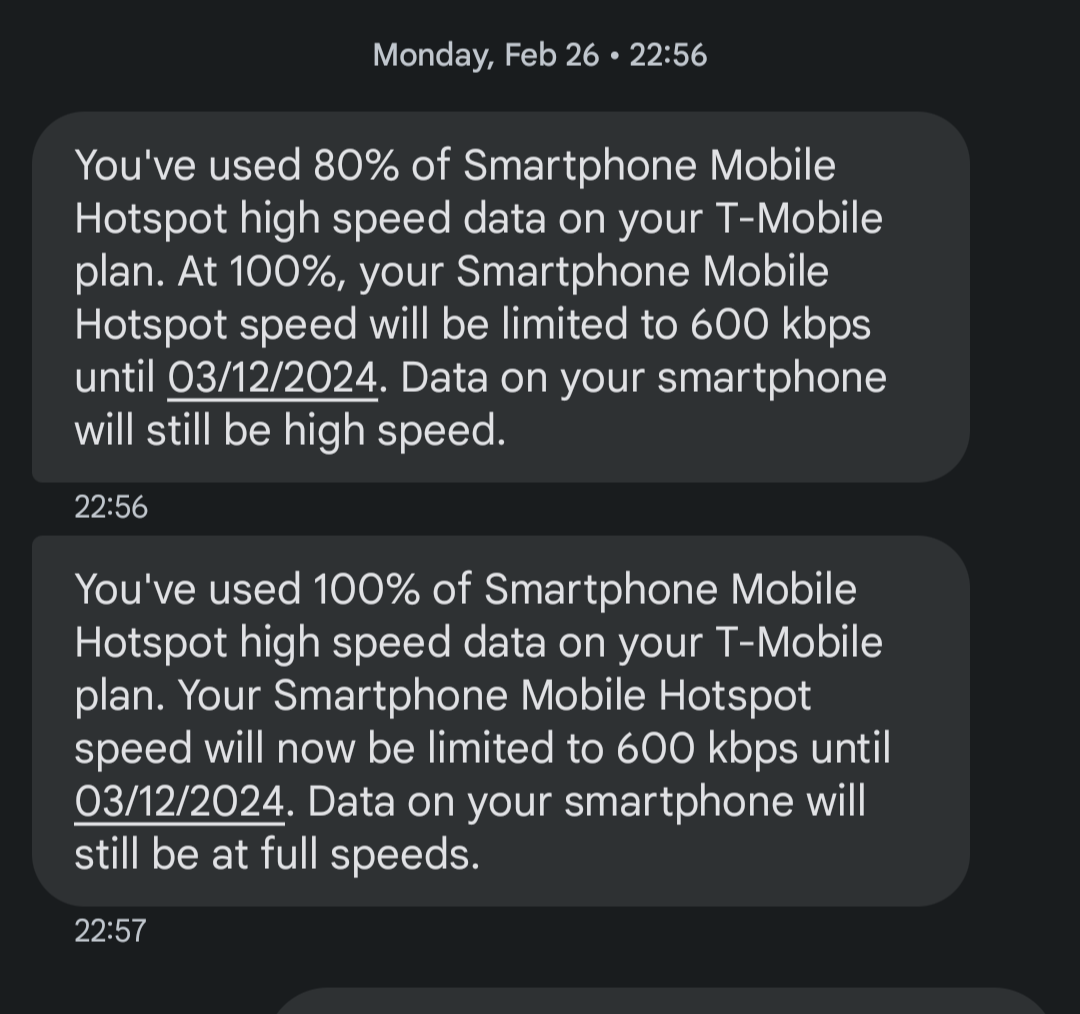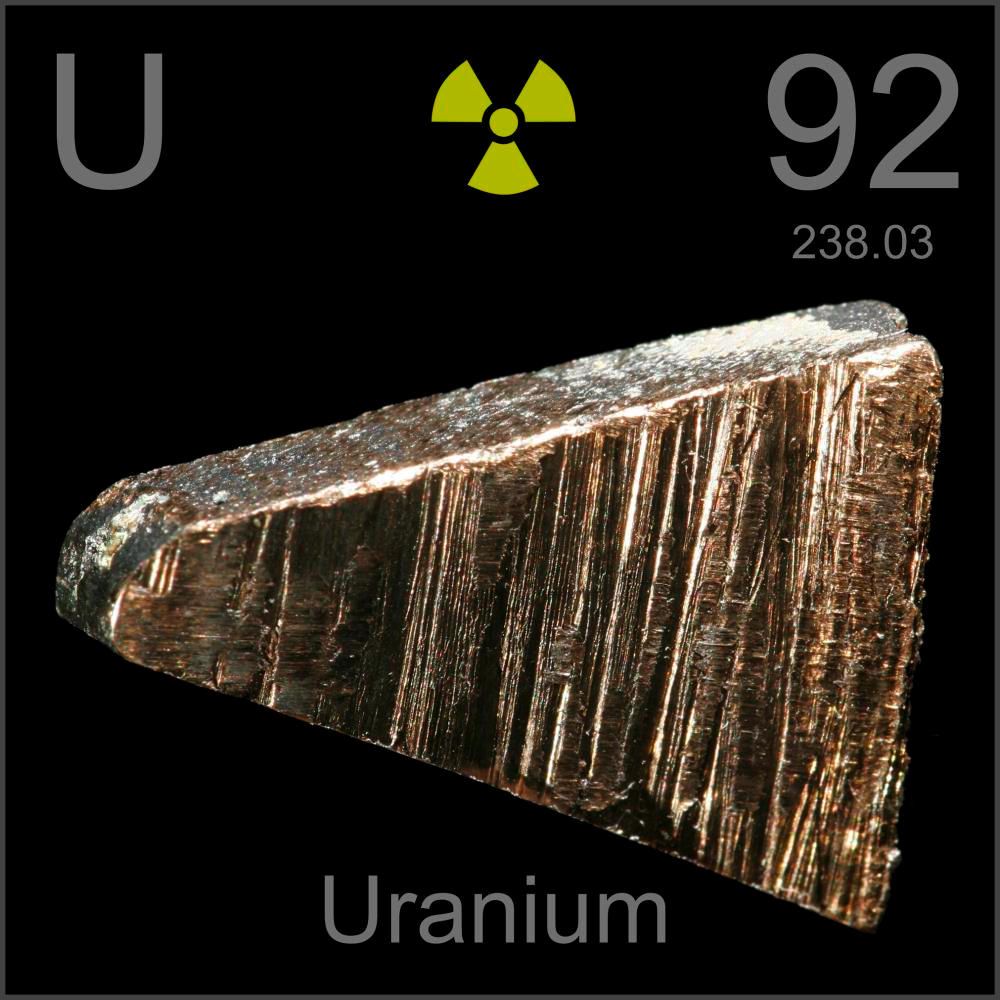What is the difference between cellular data being used on my phone and cellular data being used on my notebook? Data is data.
This is why we need net neutrality
And more competition.
Nationalize the tubes
T-Mobile hasn’t done this for years. Att is just shit
Uh?

When T-Mobile moved to unlimited with the ONE plans, they gave You “unlimited” tethering at “3G speeds”, which turned out to be 0.5Mbit/s, an unusably slow speed in 2018.
The Magenta plans gave you 5GB-50GB of full-speed tethering before dropping you to “3G speeds”. The current Go5G plans are similar, with a limited amount of usable tethering data before you’re, for all practical uses, cut off.
Before the ONE plans, there technically was no hotspot usage limit, but since you had a limited amount of high-speed data, your hotspot was effectively limited to whatever your plan gave you.
All the US carriers limit hotspot usage, partly to prevent someone hooking up a computer to download 50TB of pirated movies while clogging up the bandwidth for everyone else on that tower, and (moreso) partly because they’re greedy.
If it were just bandwidth issues, they’d only limit you during times of congestion.
It’s pure greed.
3g speeds are fine, no clue what you’re talking about. I literally tether all the time and when I hit the limit it’s still completely usable, even for YouTube. And getting to that limit is well above the 5gb from ATT. Like I said, att is shit, T-Mobile doesn’t do this and hasn’t for years.
Literally every carrier on the planet limits hotspot data in some manner. This isn’t a US thing.
Lol. They totally do. Their best plan without going arm and a leg for unlimited gives you 50GB a month before dropping to near nothing. Up to a year ago it was 40GB.
50gb is not even close to 5gb and 3g speeds are not even close to 128kbs so no, T-Mobile doesn’t do this.
T mobile has low GB plans that are far less than 40 or 50 GB and 3g is capable of over 3Mbps, so I don’t know what dumbassery you’re talking about.
128kbps is referring to the ATT limitation so you’re just proving my point. T-Mobile doesn’t do what att does.
I have T-Mobile. They absolutely do.
I have T-Mobile, they absolutely don’t.
This has little to nothing to do with net neutrality, which refers to back end L1 and L2 network interconnections.
what are you talking about? that makes no sense
Edit: wait, you might be right. As I understand, net neutrality is for the last mile ISPs, not the L1/L2 providers. So uh… what I explained below isn’t relevant. Eh, I’ll leave it in case people wanna learn stuff.
It was a bad explanation, assuming you had knowledge of network infrastructure things, but it does make sense. I’ll explain things if you’re interested.
Net neutrality is the idea that ISPs must treat all content providers equally. Your phone is not a content provider (most likely. You could run a web server on your phone, but… no). YouTube, Netflix, Facebook, TikTok, and your weird uncle’s WordPress site are content providers. Without net neutrality, ISPs can say, “Hey YouTube, people request a ton of traffic from you on our network. Pay up or we’ll slow down people’s connections to you.” The “neutrality” part means that ISPs must be neutral towards content providers, not discriminating against them for being high demand by consumers.
For the L1 and L2 part, that’s the networking infrastructure. The connection to your home is just tiny cables. I don’t recall how many layers there are, but it’s just “last mile” infrastructure. The network infrastructure between regions of the country or across the ocean are giant, giant cables managed by internet service providers you’ve never heard of. They’re the kind of providers that connect AT&T to Comcast. These are considered L1 or L2 providers. The data centers of giant companies, like Google for YouTube’s case, often pay these L1 or L2 providers to plug directly into their data centers. Why? Those providers are using the biggest, fastest cables to ferry bits and bytes across the planet. You might be pulling gigs from YouTube, but YouTube is putting out… shit, I don’t even know. Is there a terabyte connection? Maybe even petabyte? That sounds crazy. I dunno, I failed Google’s interview question where they asked me to estimate how much storage does Google Drive use globally. Anyway, I hope that gives you an idea of what L1 and L2 providers are.
I’m not a network infrastructure guy, though. If someone who actually knows what they’re talking about has corrections, I’d love to learn where I’m wrong
Net neutrality is about service to last mile customers, but it is based upon interconnection agreements across the L1 and L2 level.
ISP’s pay for a connection to L1 and L2, so their users (who pay ISP’s) can access content on those networks. Websites pay for a connection to L1 and L2 so their content can be available on those networks.
ISP’s want to also charge websites for access into their networks of users, in spite of the fact their users already pay them for access to the website content. If some websites don’t pay, then ISP’s will provide a lower service to their users for those websites. Net neutrality says ISP’s should not do this.
Differentiating between locally used data and hotspot data has nothing to do with this. Hotspot data is about the device the data is going to, not where the data is coming from, and typically (or at least traditionally, maybe not so anymore) a PC will use more data than a phone. A PC is more likely to have large multi-gigabyte downloads (eg games), although these days video streaming is perhaps the main bandwidth hog and is generally equal across all devices.
A home internet connection is expected to serve all devices in that home, while a mobile internet connection is expected to serve only that mobile device (excluding mobile broadband options, which serve multiple devices but are typically more expensive). The ISP’s network is designed with this in mind.
It is more reasonable for an ISP to only provide data to the phone you’re paying for than it is for them to throttle websites you already paid for. However, really both are kind of bullshit - usage limits in general are completely disproportionate to actual costs.
That’s not what net neutrality does, and I’m disturbed by this being the number one comment.
Are you talking about net neutrality in general, or a specific campaign that used the term? Net neutrality means all bits are equal. It does not matter where a bit is coming from, where it is going to or what it is part of.
No portion of any net neutrality bill anywhere calls for hotspot data to not be capped by a cell carrier. It doesn’t eliminate any caps for anything at all. Net neutrality means they can’t change the speeds dependant on what sites you’re accessing and that they can’t block any sites, give free data to access some sites and not others, or put them behind a pay wall. It has nothing to do with general hot spot data caps, or cell phone data caps.
Sorry how would net neutrality do anything but make them reword the policy??
The ISP shouldn’t care what kind of traffic is going through the network and show it down by type. It should be neutral to it
They can care about what device they’re providing internet to. Net neutrality is about where content is coming from.
They provide internet to the phone. What the phone does with it (e.g. provide a hotspot), is another story.
That depends on whether the connection is sold to cover one device or several.
Right… they can still impose data caps. They’ll just do the cap at the plan level, like most already do. OPs just on a cheap plan.
Net neutrality isn’t going to do a thing about this kind of stuff. In a best case scenario, you’ll end up with overall data usage limitations - no more ‘unlimited mobile data’.
ISPs meter data usage because it’s pretty much the only way they can impose some form of limitation on a finite capacity to provide such data to you and other customers - other than data rate limits (read: slower speeds). They can’t guarantee data rates in almost any setup, because ultimately, while ‘data usage’ is a bit of an artificial construct and ‘data’ is not in any way finite, the pipes that deliver the data certainly are of finite capacity. Mobile data capacity - and in fact, any wireless medium - is a shared medium, the more people try to use it simultaneously, the less pleasant it’s going to be for each individual user. Ask Starlink users in many US areas how overselling limited capacity impacts the individual user.
Mobile data usage also has different usage patterns than if you’re hotspotting your PC. You’re not going to download massive games or other bandwidth hogs to your mobile. You probably won’t be running a torrent client either. So they can give you unlimited mobile data because you’re simply not going to put as much of a strain on the infrastructure with pure on-device usage than you will with hotspotting.
This isn’t a defense of what AT&T is doing. But net neutrality isn’t going to force them to suddenly be all ethical. It’s not going to make them provision infrastructure that doesn’t fall over at the first signs of higher-than-usual load. And it certainly can’t change the physical realities of wireless data communication. In an ideal world ISPs wouldn’t be so greedy and/or beholden to greedy shareholders to be cutting corners, and instead provide sufficient infrastructure that can handle high demand.
And to those who are talking about their workarounds: you may not like it but you’ve signed a contract. That contract stipulates acceptable use, and if you’re found to be breaching the contract terms, the other party is within their rights to terminate the contract. Again, in an ideal world these contract terms would be more balanced towards the needs of the customer, but in the meantime your best recourse against unfavourable contract terms is to take your business elsewhere. And if you can’t do that, everything else is at your own risk.
If they didn’t have the bandwidth, I don’t think T-Mobile would offer home Internet and advertise it as much as they do
But where are they offering it? Big cities and densely populated areas where people have options and therefore won’t swarm to the product? Or are they offering it in small, remote towns where there’s not a lot of competition?
Where I live, mobile home internet is not available outside of metro areas and larger cities, and in the regions mobile towers are chronically underprovisioned and overloaded.
100% this
This is one of those ‘innovations’ people mean when they say capitalism drives innovation. Not the hotspot, the pointless extra charge for something your phone can just do on its own.
How do they know if the source of data is hotspot? I’d imagine there is a way to stop your phone grassing on you.
There’s different internal network configs (APNs), and hotspot uses a different one than regular mobile data. ( or at least it used to). Those can be configured and metered separately from the carrier’s end.
LineageOS, and maybe some other custom ROMs, wouldn’t do that and would put the hotspot and mobile data on the same APN to get around that.
Can confirm, switching to Graphene solved this problem for me a long while ago.
Doesn’t unlocking the bootloader break Google Pay?
Don’t know, wouldn’t touch that with a 10 foot pole.
What’s wrong with Google Pay?
the Google part
You can lock the bootloader again after the flashing process is done(because it will add the signing key of the new OS), but unfortunately the NFC Payments in Google Pay still won’t work because Google only allows it on ‘certified’ Android systems (aka only the preinstalled OS)
Isn’t this dependent on the ROM, like lineage shouldn’t be locked where as calyx is locked likewise for graphine os
Yes, afaik LineageOS shouldn’t be locked, but I was talking about GrapheneOS specifically because @wesker@lemmy.sdf.org was talking about that.
You can in theory still use Google Pay with a Magisk module called Play Integrity Fix and using a fingerprint from a different phone to pass Basic and Device integrity. I’m currently doing it on my Pixel 7 Pro.
But it has a steep learning curve and is a temporary solution that will disappear in roughly a year once Google sunsets legacy integrity methods and starts requiring Strong integrity, which can’t be faked under known methods. Google is also actively disabling fingerprints that are being spoofed, making the whole thing frustrating and even more temporary even when it works.
Just let us use our devices, sheesh.
Ugh. I was dumb and got a Samsung that was offered to me for cheap on the spot. If I had done any research I would have learned that there’s no alternative OS options. Now I’m stuck with it, because I’m poor, so I just try to avoid using it. I should keep an eye out for something used that’s compatible.
While it’s not at the same level as Graphene OS, Samsung is pretty well supported by Lineage OS. AFAIK at least in Europe Samsung phones have an unlockable bootloader, but YMMV.
Nah. Nobody’s figured out how to access the ROM on my specific model, unfortunately, and I’m 900% sure Canadian telecom oligopolists will not be cool about unlocking like that.
In my defense, if it was a laptop it would have been much less foolhardy.
I’m still hoping for LineageOS on the Nord N30 but I can’t Even find a stock ROM to root it.
Even on my unlocked, non vendor phone it seems to not recognize hotspot data as different for some reason.
Back when they just began recognizing it, they noted peculiar traffic. Desktop websites, batch downloads normally unavailable to that system. This assumes that you utilized the internal hotspot system and didn’t create a separate one. Now? Not sure whether their system is more robust but it should, theoretically, be possible to obfuscate your traffic using third party hotspot software. No clue where to look for that anymore.
I used to routinely use 100gb of data on my jailbroken sprint iPhone. Did that for almost 3 years. Never heard a peep from them. But this was forever ago.
If you used the package I think you did, that’s not unusual. Absolutely will not remember the name but there were numerous tweaks that just flipped the hotspot switch but a couple that allowed you to use a hotspot without directly using the inbuilt function. One was free and broadly used.
That was great, and you didn’t have to pay some extra tethering fee every month either (or something like that, it was so long ago for me).
TTL in the packet header is 29 instead of 30
Well that’s an easy fix.
If you root your phone and install a custom rom, you can get around it and they can’t tell.
If you’re factory, it sends that hotspot info to them.
You have to turn that feature on.
Could you install a different OS like suggested here https://dubvee.org/comment/1855949 / by Admiral Patrick below?
Yeah, installing a new OS on a phone isn’t something you do easily like on a PC.
You have to unlock the bootloader, which requires an unlock code from the manufacturer, then you have to factory reset it, and that’s even if your phone/carrier allows it. Many don’t (which is why it’s so hard for me to replace my phone…grrr).
So yeah, installing a new OS on your phone is typically going to require quite a bit of effort and some level of commitment as well as a device that’s bootloader unlockable and supported by an alternate OS (each device and model requires a custom build).
It’s…a whole thing. It really shouldn’t be, but it is :(
and that’s even if your phone/carrier allows it.
This is why you should buy the phone outright yourself then get a SIM only deal, rather than paying for your phone in contract.
Yeah I do, but SIM unlocked and bootloader unlockable are two different things. Sadly, not every phone (or even the same phones made for different carriers) are allowed to be bootloader unlocked; I have no idea why, but it is and sucks.
Yeah it’s definitely true, even with the same manufacturer it can be hit and miss. You gotta do your research before you buy.
I haven’t done it in a while, but it kinda depends on the phone, some were very easy to flash in the earlier days of Android.
Yeah, my old Moto Play G4 was a breeze. Wasn’t quite “Press any key to continue” but not much more difficult.
My OnePlus was a little more work, but that was mostly because of the OP website acting up and refusing to generate my bootloader unlock key. Also had to do things differently since it didn’t have an SD card to hold my install stuff like the Moto Play did.
I had one where you could literally run an app on the phone, no ADB or anything. Can’t remember what phone it was now but it might’ve actually been a Moto Droid
One one hand, that sounds extremely convenient. On the other, I shudder thinking what a malicious app could do with that 😆
Edit: Unless you’re talking about doing it through TWRP. I had to flash that over fastboot, but once installed to the recovery partition, I could boot into that and install the rest of Lineage and extra packages straight from the SD card. Updating the system was just downloading the new Lineage .zip to the SD card, booting into TWRP, and clicking install.
Maybe, but it’s not worth it just for a few days, which is all I’ll need it for. I just forked over $15 for another 10 gb.
$15 for 10GB?! USA phone bills are extortionate!
Yeah, it really sucks, but at least there aren’t roaming charges anymore.
Lol when I travel to the US I get 12GB roaming per month included for no extra charge.
You think our phone bills are extortionate? Try Canada. They’re worse. Which is really saying something.
I just have unlimited data in 200 countries on Fi in the US.
It’s worth it for more than a few days, custom ROMs ftw.
Personally my minimum features are:
- Long press back button to force close and kill an app.
- Call recording.
All the other stuff and customisation is just tasty gravy.
negotiate. i called my last carrier from my new carriers retail store front. they practically begged me to stay and said they’d give me everything i asked for.
What is the difference between cellular data being used on my phone and cellular data being used on my notebook?
The difference is the cellular company’s profits amount.
They had this restriction in the UK where the networks would prevent hotspots from actually working. You had to buy a special additional package.
Restriction has now vanished and there are no such limits on usage. Not sure if the Regulator intervened but it was most certainly a cash grab.
These days they still manage to rip us off by annual contract increases of RPI+3.9%. That applies even during a 2 year contract.
Not sure if the Regulator intervened
It was an EU thing before…well you know what you did
I didn’t ask for this. 😭
I think this is also an archaic model from before smart phones and the early days of smart phones. In the early days of apps, most attempted to limit data usage because most network providers charged a premium for data and the networks were much slower and smaller.
While you could tether in these early days, even before smart phones, the computer was capable of much higher data usage than the phone. These limits were put in place to protect a network that wasn’t really built for this level of load.
Old rules with good purpose turned into a way to charge more money.
Fair enough. That describes the past, but not the present, or the future.
I’ve had great success getting around these restrictions.
CalyxOS + Always on VPN (mullvad)
The secret sauce is using a Android version that allows you to share your VPN with hotspotting. I believe only calyxos and lineage allow you to do this. Since the VPN client is running on the phone, all the traffic that originates from the phone will look like phone data, with the appropriate time to live, OS fingerprinting, etc.
This can’t be done on stock Android, because it does not allow the VPN to be shared over tethering. So tethering traffic will not getting capsulated on the VPN client. There’s a security argument for this, but I prefer the user flexibility of allowing all the traffic to get VPNed.
It’s still possible to do this without VPN sharing on the phone, you can use normal tethering on a unlocked phone, like stock Android. You just have to modify the traffic signature to look like whatever the carrier is looking for. Setting the appropriate time to live, using a VPN, and doing other OS fingerprinting tricks to keep the traffic consistent. It’s much easier to use a ROM that lets you share the VPN
Great tip.
Time to live (TTL) or hop limit is a mechanism which limits the lifespan or lifetime of data in a computer or network. TTL may be implemented as a counter or timestamp attached to or embedded in the data. Once the prescribed event count or timespan has elapsed, data is discarded or revalidated. In computer networking, TTL prevents a data packet from circulating indefinitely. In computing applications, TTL is commonly used to improve the performance and manage the caching of data.
Hmm kinda makes sense
I had a provider before that blocked tethering and hotspot, the solution there was also to increase TTL on the clients connecting to the phone by 1. The phone would lower it by 1 again, making it look like data originated from there.
It’s possible to track the number of hops that a device on a network has, since TTL will be 8-bit numbers (and ususally start at 64, 128, etc.) if the TTL of a packet has 64 from the main device, the devices it’s sharing with will be 63 (and so on un the chain for N+1 hops). This may not be exactly how they do it since device fingerprinting would be way simpler, but it is a plausible way of tracking that a device is using a hotspot.
Interesting! Thanks :)
My ISP’s a dick, but to my knowledge, unlimited has to mean unlimited around here. There where months where we had Problems with our fibre, so I did everything over a hotspot from my phone. Used 100’s of GB’s no one ever complained.
Get proper consumer protection laws, people.
*Cries in American.*
unlimited has to mean unlimited around here.
This is the case in a lot of countries. In Australia, some ISPs got fined a lot of money (something like $300,000 I think?) because they advertised mobile phone plans as “unlimited” when in reality they slowed down the speed once you hit a limit.
Dunno if 300k is necessarily a lot for an ISP, but having rules and fining firms for non-compliance is pretty nice.
it’s not especially in the US, i’ve seen ISPs essentially break kneecaps forcing the consume to pay for the initial hook up, and then immediately rolling it out to every available house in the subdivision or neighborhood.
That shit should be illegal. If you do the math on how long it would take to profit from running it yourself it’s only a few years given an ENTIRE neighborhood.
The maximum ISPs could be fined for misleading/deceptive conduct (including things like this) was $1.1 million at the time, and I don’t think they considered this bad enough to hand out the maximum fine. They bumped the maximum to $10 million at some point afterwards though.
Get proper consumer protection laws, people.
And if you’re homeless, just buy a house 🫶
It wasn’t supposed to be quite serious, but yeah, depending on where you live it’s pretty much a lost cause, at least in the short-, or even mid-term.
Bad comparison.
It really is the same energy
Get proper consumer protection laws, people.
California is trying its best, but I’m not sure the other US states will get onboard (except New York, and maybe Oregon and Washington state).
Yeah. I mean, the state I live in right now just passed a bill to forbid officers of the state from using gender neutral, but technically grammatically incorrect language, while the ruling party is campaigning on not being a party of bans, while claiming their rivals are, so things aren’t all that green here either.
I say take the wins you can get.
Removed by mod
Which is bullshit. Who cares if you download something at full speed on your phone or through the hotpot? A bit is a bit, doesn’t matter where it ends up when received by the phone’s modem.
It’s a sneaky way of having a bandwidth cap without having a bandwidth cap. Mobile devices have smaller storage, so you’re less likely to use as much bandwidth compared to a laptop. Also a single device going to use less data than multiple devices sharing a hotspot.
Jokes on them, I have a 512GB micrSD card and I use Termux to archive videos through YT-DLP.
Was just going to say… my phone has 512GB storage and can do direct WiFi file transfer to my computer without a hotspot. All without using the mobile hotspot feature.
You can burn through a huge amount of data streaming 4K video on your phone without using any storage. You can also plug a 20TB USB hard drive into your phone, connect to a VPN and torrent away.
But most users don’t. And that’s what they’re counting on.
The carrier who’s paying for your traffic. You’re most likely going to use a lot more data on a computer than actually on your phone.
The carrier who’s paying for your traffic.
soooo… what’s with the monthly bill then?
I mean let’s be real, it’s incredibly complex and amazing technology. Borderline magic. And depending on where you are, yeah consistently using large amounts of bandwidth can and will impact other users.
So a policy like this makes sense, to a point. It’s when they auto charge you for hitting a “limit” that grinds my gears.
And I’m sure we can all acknowledge what would happen to prices if there were zero restrictions. A top budget blogger tip would be “stop paying for your expensive broadband service! Plug your phone in and tap “hotspot” in settings to save $50-$100 a month.“
Normies (grandmas using Facebook, not WFHers/gamers) would be frivolous to pay for two “equivalent” Internet services.
(Before you think me a corporate lobbyist, know I submitted a complaint to the FCC when Comcast first implemented broadband bandwidth caps in the USA. Saw that BS in Canada.)
Less than it would be if they expected you to go full ham 24/7.
Username checks out.
If it’s an android phone, enable dev mode, install adb on your laptop, run an sshd under termux on the phone, and you should be able to set up iptables to forward packets from the laptop through the phone. The phone won’t know that it’s being used for tethering. Although I hadn’t seen the stuff about packet TTL before. Maybe it’s as simple as just adjusting that.
A less complicated method that I used for years:
- Install SimpleSSHD on your phone
- If you’re running Windows, install PuTTY on your PC
- Connect to SimpleSSHD through PuTTY/ssh and set a parameter for dynamic forwarding (CLI option is
-D 8888) - Set your web browser or application to use SOCKS5 proxy at
localhostport8888
It doesn’t redirect all traffic (you’d want to avoid system updates, for example) but might be easier than messing with iptables.
There is an app that can change TTL value through
iptables. It requires root.It may be easier to just run a VPN on the phone and route the traffic through it? WireGuard runs on Android. I’ve never tried configuring it to forward data through it though, but it should work.
I tried that, the carrier could still differentiate it from local traffic (or at least my speed test results were vastly different).
It’s possible they’ve gotten smarter these days.
I don’t know how ISPs are allowed to do this when it’s a very obvious violation of net neutrality.
If I recall correctly, they justify it by claiming they need to do deep packet inspection to balance traffic. There’s a fuzzy line between them needing to optimize their network equipment and respecting privacy, and the rulings seem to favor the former.
Back in the day PDANet was the app to go to enable unlimited tethering.
Still works for me as of last year. Now I use rooted android with ttlfix.
This is what I’ve been using and it works for the most part other than the connection just dropping with too much use, only other thing I’ve used is PairVPN which had the same problem but was 100x worse. Is there something better around nowadays? I have a carrier locked phone and can’t ROM or root
Att et al keeps throwing around the word ‘unlimited’. I actually had a conversation with Verizon, before I dropped them, and actually used this exact quote to the guy…
He was like, “princess bride. Nice. But, yeah, I have to read the script.”
Data is data in the same way water is water and electricity is electricity; nobody should have the power to dictate how you use it. I really wish we’d enshrine genuine net neutrality and shut this kind of nonsense down.
Except there is not a physical commodity or production at the other end of which they are supplying me a portion of a finite amount. If they “pipe” is big enough to supply what is promised to every end user it is supplied to, the water company or power company can still run out of water or power if one person uses a ridiculous amount. The ISP can’t run out of “data”, they aren’t even supplying it - it comes from a host. The ISP is just responsible for running the cables, or “connecting the pipes”.
The ISPs loves using the comparison to water or power, because you get charged more for using more of either and that is how they have convinced lawmakers (who are so old and out of touch they have no idea how the internet works) that using more data should cost more. They’ve convinced our lawmakers basically that they have a big “tank full of data” and if I use too much, there wont’ be any for my neighbors.
The truth is they are selling me something they can’t provide - a 250Gbps “pipe” that can’t actually supply 250Gbps if everyone they sold it to wants to use it at the same time. They sell the same pipe to the whole neighborhood and blame the neighborhood when they try to use what they were told they bought.
Except there is no ‘unlimited’ for water or electricity.
There used to be
Well that’s because,
fuck you pay methose are special data packets.Ahahaha, are you in marketing?
No, I’m far worse. I studied politics in college.
My condolences.
you also have unlimited data, unless you hit a data cap, and then you hit a data rate limit, so technically your data is actually limited.
Can we legislate these fucks to just actual provide the bandwidth they claim to? I.E. a max cap of the max bandwidth * the max amount of time it can be available for in a billing period. Anything else is fraud IMO.
We had legislation for this stuff. Then Trump put Shit Pai in the FCC chairman spot and proceeded to gut all of the net neutrality and consumer protection regulations.
ajit pai* or however the fuck you spell it, idk im american, i have no culture.
It’s a really weird and very American problem. Our home broadband either doesn’t exist or is really expensive in any given market, and tends to have clauses, conditions, etc. Like Comcrap limiting people to 1TB/mon (very easy to burn through quickly by just watching some television programs) unless they pay more for “unlimited”. People, as taught by Capitalism, hunt for the best deals. Paying one bill instead of two saves money. Some have light enough home Internet requirements that they don’t need expensive home broadband.
Then the companies get pissed that we’re doing what we are supposed to do, find the best deal for our needs, so they set up false gates to make sure we follow the path they want us to follow. Then they pay off the regulatory agencies to allow terms like “unlimited” mean not unlimited, 3G HSPA+ being known as 4G. 4G being known as LTE, 4GLTE or 5Ge. 5G being known as 5G, 5G+, 5GUW, 5GUC, (even though, with the exception of T-Mobile in many markets, that 5G will actually be non-standalone and anchored to an LTE packet core, not 5G SA) and all the other damn arbitrary marketing buzzwords. All of which really mean nothing because the 5G spec allows a carrier to flip on the 5G availability flag on a phone even if 5G doesn’t exist in your market.
Most of this, AT&T is the biggest perpetrator of by far. Especially the lying about 5G.
The rules are all made up, nothing is real. Time for the arbitrary monthly bill increase for no reason! Pay up, chump!
I still feel like I should be able to sue AT&T for claiming my hotspot is “unlimited,” but after 15 gb it drops to double digit kbps. Seems like that’s a pretty hard limit
Especially given:
- Limited to 15GB
- Then limited to 128kbps
The 15GB is going to be variable based on the link speed available. If full 5G, that can be erased with 15 speed tests in a few minutes.
From there, it’s 128kbps * 3600 (to hours) * 24 (to days) * 30 (to month) = 331,776,000 kilobits -> 41.472GB + the original 15GB -> 56.472GB is the limit each month for “unlimited”, roughly. A hard limited number.
And some douchebag could come in and say “um, actually, it’s always going to be limited because the internet speed isn’t infinite” as if the 3TB my mobile data is capable of downloading at full speed is at all comparable to the 0.05TB I can get after they rate limit me
Yep, lack of broadband in this AirBnB I’m staying in is the only reason I was using it as a hotspot in the first place. The speed here is about the speed they’d throttle it at. I kind of had to fork over the $15 or deal with slow internet one way or the other.
It always blows my mind going to a rental and the rental has no or lacking Internet. Yes, I’m probably on vacation, but it’s the future and life requires a few megabits. Years back I made it standard procedure to prep some kind of mobile broadband for my destination (buying a month of prepaid for a hotspot or whatever) fully expecting it to just always suck, it’s annoying that this is still a necessary procedure in 2024.
Unfortunately, I didn’t pick it. My mother is paying. And when I asked my mother if she looked to see on the AirBnB ad if this place had high speed internet, she said, “other ads did, but this one didn’t.” Sigh.
Unlimited with a limit
You see, this is why we need net neutrality
EDIT: see, im glad someone else said it already
Net neutrality really wouldn’t stop this, just make them reword the limit.
No differentiation of traffic. Eg hotspots vs mobile apps can’t be a separate limit. So 5Gb/month has to be for everything or it must be for nothing.





















